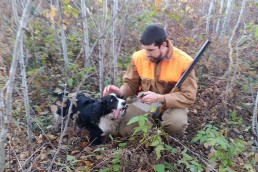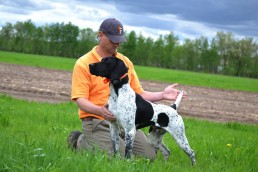It’s Not Too Late to Buy a Bird Dog
SHARE THIS POST
I was following my German shorthair Annie through some state forestland when a woodcock rocketed out of a tangled thicket. I quickly got the barrel of my shotgun in front of it and squeezed off a round.
The bird fell, but where?
The thicket may have been about the size of a barn floor with less-dense vegetation surrounding it. I began walking around the tangle to the area where the bird fell. I knew I had little chance of finding it.
My shorthair came rambling in from somewhere and went on point. Thinking she might be pointing another woodcock, I walked forward to flush the bird. Nothing flew. Impatient with my dullness, Annie clambered in and picked up the bird I had just shot.
Score one for the dog.
Annie was young and inexperienced. In her second season during the low part of the grouse cycle, she’d had little exposure to live game birds. She sometimes ranged too far ahead of me, blew through good-looking cover and had a tendency to crowd birds. Her work lacked polish, and I couldn’t expect her to perform flawlessly. Still, she was making important contributions to my hunting. In my experiences with her, this philosophy had its seeds: Even if you think you don’t have time to train it well, get a dog. Even an imperfectly trained dog can contribute to a hunt.
At times, of course, a young dog will cost a hunter birds. If you have a high-energy pointer that bumps birds and chases them, you may want to do more training with him before taking the dog out on actual hunts. If a person has a close-working pointing dog, like German shorthairs, that dog could be an asset even if it crowds birds on point and flushes a few. After all, what is the difference between a pointer that flushes birds and a flushing dog?
The answer? There isn’t one. They can both put birds in the game pouch. In fact, a key attribute many bird hunters want in a dog is the instinct it has to “stay” in the neighborhood.
Are you enjoying this post?
You can be among the first to get the latest info on where to go, what to use and how to use it!
Devoted English setter or Brittany fans may debate me on this, and they have a point: If someone likes a dog that goes out and covers lots of territory can blame him? For those dogs to be of any use though, they need to have nose enough and the right instincts and training so they point birds instead of flushing them, and hold their points. It takes lots of training time and birds to get dogs to that point. Most of us don’t have that much time to devote to dog training.
By working close, a dog can atone for a lot of sins. When the dog accidentally flushes a bird, it really is no big deal if the dog is nearby. Some of us even seek out such dogs.
Once, when a beloved pointer passed away unexpectedly late one summer and no young dog was waiting in the wings, my upcoming bird season promised to be a bleak one. I committed a heretical act for a former pointing dog owner: I bought a spaniel.
My reasoning went like this. Even taking my any-bird-dog-is-better-than-no-bird-dog philosophy into account, I didn’t want to take too young a pup into the woods. I wanted to shoot some birds, and I didn’t want to ruin a dog by rushing its development. It is one thing to shoot the bird a pointer occasionally bumps; it is entirely different reinforcing the flushing instinct in a young pup. Even my philosophy has an age limit attached.
Taking a very young flushing dog into the woods, though, is a different thing altogether. She would get acclimated to the woods and get to actually feel feathers in her mouth and possess the main qualities I wanted to enforce—hunting close and putting birds up—and she would be able to perform just fine. She would have some flaws, sure, but she and I both would have a lot of fun.
The plan worked to perfection. I kept my expectations in check that fall and just let the pup have fun. She scented birds and even flushed some in the air that I shot that she brought back to me. She is now a full-fledged hunting partner. She made an impressive retrieve last fall when my son-in-law dropped a grouse we couldn’t find—my English springer spaniel found it. Although we kept calling her back to the spot where the bird fell, she insisted on leaving the area. When she was some 100 yards away and ignoring my calls, I began to get suspicious. About then, my son-in-law saw a grouse trying to get airborne just cresting some waves of fern. The dog caught the grouse and brought it back to us. About to begin her fourth season, she knows my expectations for her, and she is always eager to hunt.
The point is anyone who wants a bird dog should get one. It may not perform the way the dog of our dreams would, but we are unlikely to ever have that dog anyway. Almost any breed of dog will make an important contribution to the hunt if we are patient with it and appreciate its strengths rather than dwell on its weaknesses.
Whether polished or not, bird dogs are invaluable for putting birds in the air and finding the ones that have been downed. Matt Hildebrand, Andy Duffy’s son-in-law, shot this woodcock that Duffy’s English springer spaniel flushed out last fall.
MWO
SHARE THIS POST
Did you enjoy this post?
You can be among the first to get the latest info on where to go, what to use and how to use it!
Andy Duffy
Andy Duffy enjoys a wide variety of outdoor activities. He especially enjoys fishing creeks for trout and hunting grouse and woodcocks. He writes from his home in rural Michigan, far away from any major cities.



